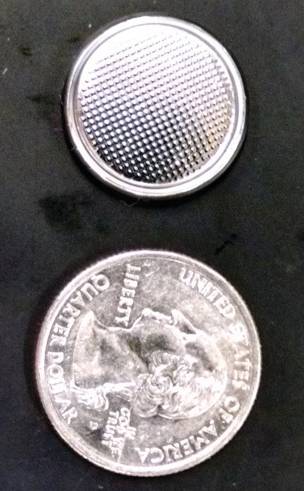
New hybrid device combines the best of biofuel cells and supercapacitors
|
|
| A dime-sized hybrid device that integrates a supercapacitor into a glucose biofuel cell (top) delivers high energy and high power for medical implants. |
Because glucose is energy dense and abundant in the body, scientists have been trying to use it in fuel cells to power medical implants. Glucose fuel cells made so far store a large amount of energy but cannot deliver it in the quick bursts that an implant, such as a pacemaker or brain stimulator, needs. Now, researchers have made a compact device that delivers such bursts by combining a biofuel cell with a supercapacitor (ACS Energy Lett. 2016, DOI: 10.1021/acsenergylett.6b00225).
Fuel cells convert energy in chemical fuels into electrical energy. Unlike batteries, which need to be replaced once their stored chemicals are exhausted, fuel cells work as long as the fuel is replenished. Fuel cells that run on glucose in the bloodstream could be an ideal alternative to today’s lithium-ion batteries for driving implanted devices. Plus, glucose fuel cells can store roughly 10 times the energy of lithium batteries. Scientists have demonstrated that biofuel cells can work when implanted in insects, lobsters, and rats.
But fuel cells have low power density, which means they cannot generate quick, high-energy pulses. Batteries also face this limitation, so for current medical implants, manufacturers connect batteries to high-power supercapacitors, devices that can provide quick power bursts. “The battery charges the capacitor, and the capacitor handles those short time periods when you need bursts of power,” says Shelley D. Minteer of the University of Utah.
Minteer and her colleagues adapted the strategy for biofuel cells. To save space, they incorporated the supercapacitor into the biofuel cell instead of stringing two separate devices together. Glucose fuel cells typically contain carbon electrodes coated with enzymes that catalyze redox reactions to produce an electric current. In the anode, the researchers loaded an oxidizing enzyme, glucose dehydrogenase, into a coating made of a redox polymer, polyethylenimine, which stores charge and acts as the supercapacitor.
As glucose oxidizes, electrons travel through an external circuit to the cathode, coated with a reducing enzyme, bilirubin oxidase, thus creating an electric current. Some of the electrons produced charge the capacitive polymer layer, Minteer explains. Then during spikes in power demand, the supercapacitor discharges to provide the needed high-energy bursts. The researchers encased the device in mesh so that blood would be able to flow across the electrodes, providing a constant supply of glucose.
Others have attempted to make biological supercapacitors using conductive polymers, but those do not have a large enough capacitance to be practical. This new device, about the size of a dime, has a capacitance of 300 faradays per gram, more than four times higher than previous devices while delivering comparable voltage.
Minteer is working with the Salt Lake City-based startup 32ATPs to commercialize the technology. The researchers are now trying to increase the device’s capacitance by coating the cathode with the redox polymer as well.
Daniel A. Scherson of Case Western Reserve University says that the approach of hybridizing a biofuel cell with a supercapacitor is novel. But the barrier to implants powered by biofuel cells could be the short lifetime of the enzymes, which break down after a few years. Applications such as short-term sensors and electronics could be more suitable, but no one has yet demonstrated such devices. “Biofuel cells will only take off when there’s a reliable application,” he says. “In the long term, that’s the Achilles heel.”
- Chemical & Engineering News
- ISSN 0009-2347
- Copyright © 2016 American Chemical Society
